By TZ Business News Staff.
Tanzania’s fiscal year 2018/2019 has inherited steady economic growth from the previous year on account of large infrastructural spending.
Economists associate large infrastructural development spending to steady economic growth–especially where infrastructural development spending is directed toward energy, water, transport and telecommunications.
Tanzania’s annual GDP growth rate for 2017 is now determined to have been 7.1% for March 2017 compared to 7.0% at the same time in 2016, the Government Spokesman and Head of Tanzania Information Services Dr. Hassan Abbas told reporters in Dodoma on July 25, 2018.
The 7.1% GDP growth rate disregarded downward risks identified by both the World Bank and International Monetary Fund (IMF) who predicted Tanzania’s GDP growth would shrink down to somewhere between 6.6% and 6.8% in 2017 down from an average of 7.0% the year before.
The Breton Woods institutions warned the business environment was not conducive for growth, that the Government would most probably not get the money it needed for development expenditure while the private sector was cash strapped from an un-conducive bank borrowing environment–both of which were feared to impact economic growth negatively.
At the press briefing in Dodoma, Dr. Abbas attributed the 7.1% growth to implementation of big development projects and the good leadership of President John Pombe Magufuli. He however did not explain where or how the Government raised the funds used in the big development projects.
“The [2017] economic growth resulted from implementation of big development projects as well as various other economic activities,” he said. “In 2017 the Government continued to implement water projects in the villages in order to make water available and over 366 projects are still under implementation across the country.”
Dr. Abbas said in 2017 an assortment of tarmac and gravel roads were built for the length of 32,170 kilometers compared to 30,265 kilometers of roads built in 2016, an increase of 6.3%.
The Government spokesman also identified huge rolled over infrustracture projects currently in progress. These include Kinyerezi-1 gas power project which will produce 185 Megawatts of electricity on completion and Kinyerezi-II which currently supplies 208 megawatts into the national power grid but which will produce 280 megawatts on total completion.
Work has also started for construction of Stigler’s Gorge power station, a historic hydro-electric power generation plant on the Rufiji river which is planned to produce and supply into the national power grid some 2,100 Megawatts of electricity.
Reuters has also reported in the past plans exist to spend $14.2 billion over the next five years to build a 2,561 km-railway network and to upgrade ports and roads to serve growing economies in the surrounding region.
In January of 2018 the IMF repeated its cautious comments on the Tanzania economy regardless of the resilience cited by the Government spokesman.
Tanzania’s recent economic performance has been mixed and the outlook is subject to emerging risks, the IMF said in a statement in January. Although GDP data point to continued strong growth, other high frequency data suggest a weakening of economic activity.
Tax revenue collections are lower than expected and credit growth has stagnated reflecting in part banks’ rising nonperforming loans (NPLs).
Inflation remains moderate, and international reserves have increased substantially. There are downside risks to economic growth in the short term stemming from slow budget implementation, a challenging business environment, and private sector concerns about authorities’ enforcement of rules.
Program performance under the PSI has been broadly satisfactory. Most quantitative targets for June and September 2017 were met. While progress in structural reforms has been mostly slow, efforts have been boosted to advance them.
Macroeconomic policies will need to be closely coordinated. After recording a small fiscal surplus in July-September against a programmed deficit, the government is planning to step up budget implementation, particularly in development spending. The monetary policy stance and liquidity forecasting and management will need to be closely coordinated with fiscal developments.
Strong growth and job creation are needed to address high poverty and a large underemployed youth population. Infrastructure gaps and the business climate have also become increasingly challenging and require response. Sustained reforms will be needed to achieve the strong private sector-led growth envisioned by the government’s development plan.
Budget credibility and implementation need to be improved and arrears prevented. Additional domestic revenue needs to be mobilized through tax policy and administration reforms, while improving the functioning of the VAT refunds system. Addressing the high stock of NPLs is a priority to reduce financial sector vulnerabilities and revive credit growth.





